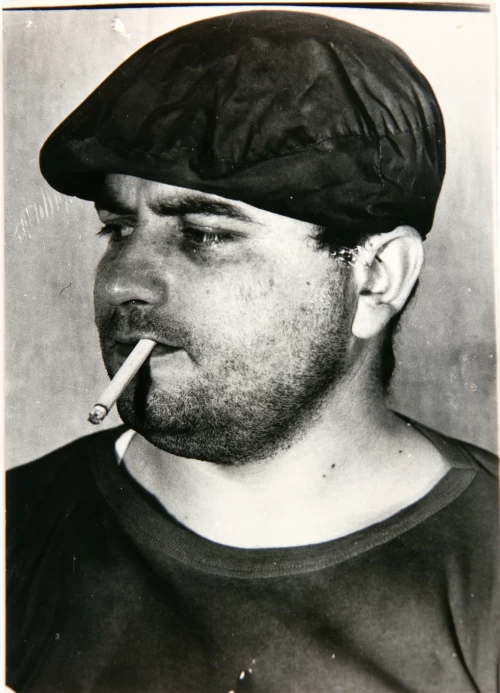The artist Ludwig Schönherr, also known as Peter Schönherr and Ludwig Winterhalter, was born as Günther Helmut Peter Schönherr in Nordhausen, Thuringia on May 30, 1935. He died in Berlin on September 30, 2016. After various work experiences in his teens and early twenties – including construction, the printing business and assistance jobs in theater and opera – Schönherr dedicated himself to writing in the late 1950s and early '60s. He contributed articles to theater programs, worked on a novel, and wrote numerous plays and three ballets, including PARKPLATZSORGEN [PARKING LOT WORRIES] and UTOPIAVILLE. Schönherr also began engaging seriously with the medium of photography. In 1963 he married the dancer Beatrice Cordua in Cologne. After the couple moved to Frankfurt in 1966, Schönherr began to dedicate himself to Super 8 filmmaking. His early film projects were organized into series that focused on objects, faces and zooms.
Schönherr with Batman and Superman, 1960s
In 1967 he bought his first black and white television set which inspired him to an intensified intellectual and artistic preoccupation with television images. Over the next few years, he made dozens of single- and multiple frame silent Super 8 films of television images interrupted by flashes of color that he titled “Electronic Films” or “TV Art.” In the early 1970s, Schönherr also began work on photography projects with images that were shot off television. In accompanying written texts and notes, he theorized some of his work as “Structural Photography” and “Absolute Photography” and considered the carefully structured contact sheet as his end product. The culmination of his artistic and theoretical engagement with television is certainly the multi-part project BILDERINFLATION [IMAGE INFLATION], 1977-78, which includes a year long work in which Schönherr shot a roll of film of television images every day according to a carefully conceived score. The result is 365 structured and enlarged contact sheets that attempt to lend order and form to the influx of images in everyday life.
Page from Schönherr’s work journal, 1964
In 1978 Schönherr legally changed his name to Ludwig Winterhalter to avoid confusion with his brother the Zürich based experimental filmmaker Klaus Schönherr. He quickly resumed work, however, once again with the last name Schönherr. Throughout the 1980s he suffered from various illnesses which hindered his ability to realize his artistic projects. Over a five-year period in the mid-1980s, he completed DAS UNBEKANNTE HAMBURG [THE UNKNOWN HAMBURG], his only film to have received cultural funding and his only work on 16 mm. After living temporarily in Berlin, Cologne, Frankfurt and Hamburg, Schönherr settled permanently in Berlin in 1994. During the 1990s and 2000s, he turned to computer editing software to create new digital images and to redesign his earlier photographs.
Schönherr (right) with friends, 1970s
Throughout his life, Schönherr was reticent about presenting his work to the public. Aside from a random single screening or the rare participation in an exhibition, he didn’t show any of his work in film, photography, drawing and installation until the last decade of his life. Despite his obscurity, Schönherr was active on the fringes of the vibrant burgeoning European avant-garde film scene of the late 1960s and early ’70s. In 1970 he documented two Otto Mühl actions. He maintained a close relationship with the artist Dieter Roth, with whom he collaborated on films and photography projects. In 1983 he shot numerous photographs of Jack Smith during Smith’s stay in Hamburg for a performance festival.
Portrait of Schönherr, 1970s
In addition to these artists, his films and photography projects feature appearances by Anna Opperman, Kurt Kren, Dieter Meier and Nam June Paik. His work (credited to Peter Schönherr) receives brief mention in Birgit Hein’s pioneering 1971 book FILM IM UNDERGROUND as well as Stephen Dwoskin’s 1975 book on international avant-garde cinema FILM IS.
A selection of Schönherr’s films are available for rent through Arsenal Institute for Film and Videoart in Berlin.
Schönherr frequently rewrote his biography





